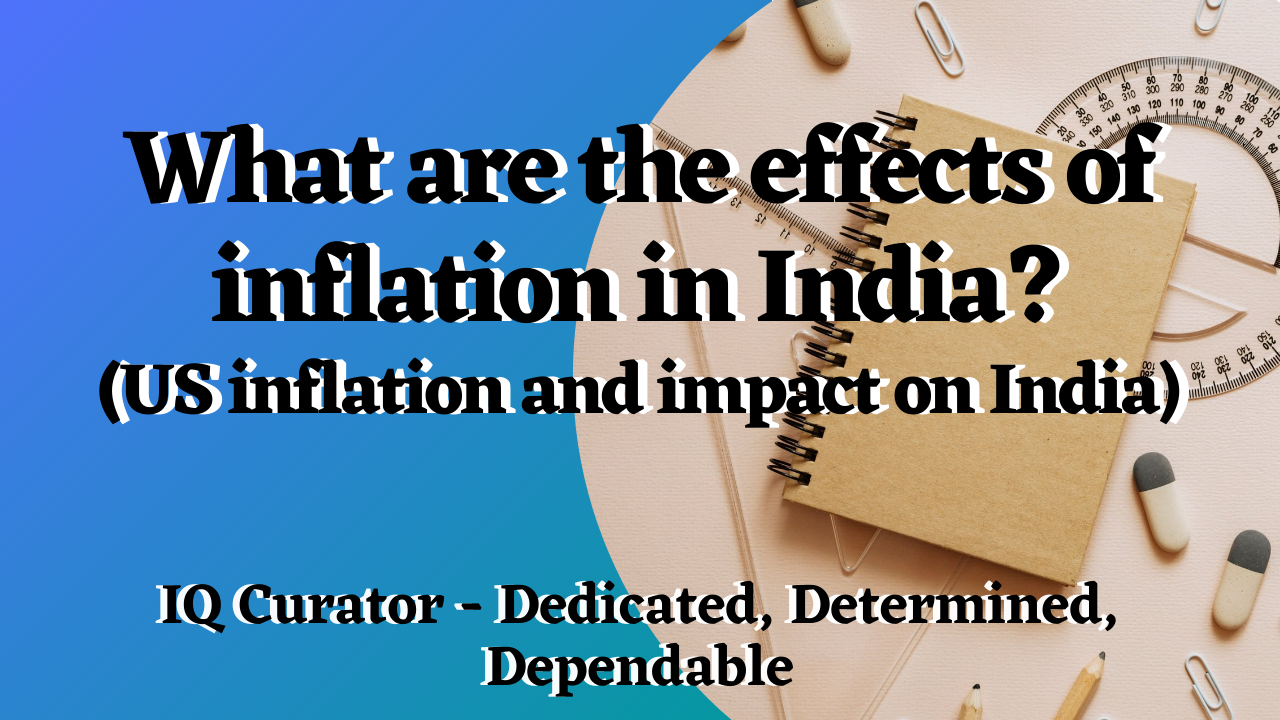Retail inflation in the US (United State America) has risen to 6.2% in the last few days, the highest annual increase in three decades. These rising prices have attracted attention both globally and in India.

(US inflation and impact on India 2021)

Back to basics: About inflation
Mechanism
- This is the rate at which the price increases during a given period. In general, the rate of inflation in India is calculated on an annual basis.
- In other words, if the inflation rate for a particular month is 10%, it means that the price of that month was 10% higher than the price of the same month a year ago.
- Inflation in India is mainly measured by two main indicators - the Wholesale Price Index (WPI) and the Consumer Price Index (CPI), which measures price fluctuations at the closing and retail levels, respectively.
- India has adopted a flexible inflation policy targeting 4 (+/- 2) percent.
The Effect of Inflation on People:
- High inflation destroys people's purchasing power. Since the poor have less money to cope with rapidly rising prices, high inflation hurts them the most.
- However, in order to increase production in the economy, it is necessary to maintain a moderate level of inflation.
Reasons for rising inflation in the US:
- The US Federal Reserve has set an inflation target of only 2% in its Federal Reserve. Based on this reference, the inflation rate of 6.2% is the highest increase in prices.
- An increase in inflation can usually be attributed to either an increase in demand or a decrease in supply.
- Both factors are involved in the US.
- The pace of economic recovery has been much faster than the improvement of the supply chain and has exacerbated the demand-supply imbalance, which has led to a steady rise in prices.
Demand-Based Inflation:
- The rapid rollout activities of the COVID-19 vaccination campaign led to a rapid recovery in the US economy.
- Part of the rise in inflation came from an unexpectedly rapid recovery in consumer demand.
- The recovery was fueled by billions of dollars raised by the government not only to provide relief to consumers and those who lost their jobs, but also to stimulate demand.
Supply Side Inflation:
- In the year 2020, the epidemic caused widespread lockdowns and disruptions not only in the US but all over the world.
- Companies reduced the number of employees and Intense reduced production.
- In short, the global supply chain of production has not resumed production at pre-epidemic levels.
Global inflation:
While the US has seen the fastest rise in prices, in most major economies, Germany, China or even Japan, inflation has taken policy makers by surprise.
Inflation (Indian Perspective)
Pre-Pandemic Inflation:
- While most other economies were hit by the rise in inflation following the epidemic, India was one of the rare major economies with high inflation before the epidemic.
- Although epidemics have exacerbated the situation due to supply constraints, demand in India has not yet reached the level of Covid.
- As a result, the RBI has not cut its benchmark interest rate (repo rate) even once since May 2020, despite India entering a "techno" recession.
- The RBI has decided to continue the favorable trend as long as necessary to revive and sustain growth on a sustainable basis and reduce the impact of Covid-19 on the economy, while ensuring that inflation continues to rise. Stay within the moving target.
The Main Worrying Factors of Inflation are:
- While overall inflation averages appear to be fairly manageable at present, "major" inflation is worrisome.
- The main rate of inflation is the rate of inflation when we ignore the prices of food and fuel.
- This rate is high and now threatens to breach the RBI's comfort zone.
- In light of the global surge in prices, India's inflation is likely to worsen.
Impact of US inflation on India
- When prices rise globally, this will lead to higher import inflation. In other words, India and everything they import will be expensive.
- High inflation in advanced economies, especially in the US, will force their central banks to abandon their loose monetary policy.
- Strict monetary policy in advanced economies will encourage higher interest rates.
- Tighter monetary policy includes raising interest rates to force borrowing and encourage savings.
- This will affect the Indian economy in two broad ways.
- It will be costly for Indian companies trying to build wealth outside India.
- The RBI will have to adjust its monetary policy locally by
raising interest rates locally. This in turn could lead to higher inflation as
production costs would increase.
Welcome to IQ Curator’s General Knowledge - All Competitive Exams Questions - Answers Section. This section is a various topics & category-wise archive of IQ Curator’s GK (General Knowledge) Questions – 2021-2022 in Short MCQs format on various subjects and states. This section is suitable for aspirants preparing for UPSC-IAS, SSC-CGL and State Level Examinations of various states and also UPSC conducted NDA/ CDS/ IFS/ IES / CSE, SSC, Banking / IBPS, IAS, NTSE, CLAT, Railways, NDA, CDS, Judiciary, UPPSC, RPSC, GPSC, MPSC, MPPSC ,etc. examinations.
Please Click Here for : IQ Curator - South Korea Tests Control of Air Taxis
You may also Click Here for : General Knowledge - All Competitive Exams
Good Luck!

